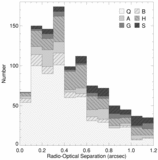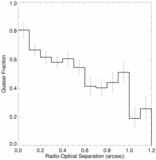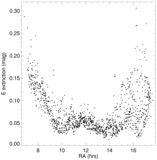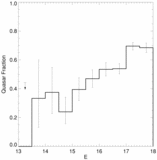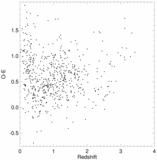Image Details

Caption: Fig. 15.
Left: Histogram of radio‐optical ratio ﹩R^{*}﹩ (Stocke et al. 1992) for FBQS quasars. Shaded area represents previously known quasars. The dotted histogram includes ﹩R^{*}﹩ upper limits for Véron catalog objects in the FBQS area but not detected by FIRST. The Véron quasars (shaded plus dotted histograms) show a bimodal distribution of ﹩R^{*}﹩, with a dip around ﹩R^{*}=3﹩–30, but the FBQS quasar counts rise continuously through that region and show no obviously evidence for bimodality. Right: Fraction of newly discovered quasars vs. ﹩R^{*}﹩. The FBQS is increasing the number of known objects in the radio‐quiet/radio‐loud transition region (﹩R^{*}=1﹩–100) by a large factor.
Copyright and Terms & Conditions
© 2000. The American Astronomical Society. All rights reserved. Printed in U.S.A.



